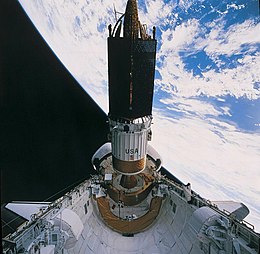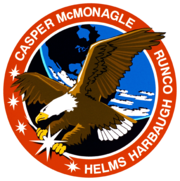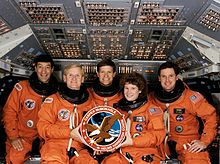 Endeavour deploys the TDRS-F satellite. | |
| Names | Space Transportation System-54 |
|---|---|
| Mission type | TDRS-F satellite deployment Technology research |
| Operator | NASA |
| COSPAR ID | 1993-003A |
| SATCAT no. | 22313 |
| Mission duration | 5 days, 23 hours, 38 minutes, 17 seconds |
| Distance travelled | 4,025,415 km (2,501,277 mi) |
| Orbits completed | 96 |
| Spacecraft properties | |
| Spacecraft | Space Shuttle Endeavour |
| Landing mass | 92,988 kg (205,003 lb) |
| Payload mass | 18,559 kg (40,916 lb) |
| Crew | |
| Crew size | 5 |
| Members | |
| Start of mission | |
| Launch date | January 13, 1993, 13:59:30 UTC (8:59:30 am EST) |
| Launch site | Kennedy, LC-39B |
| Contractor | Rockwell International |
| End of mission | |
| Landing date | January 19, 1993, 13:37:47 UTC (8:37:47 am EST) |
| Landing site | Kennedy, SLF Runway 33 |
| Orbital parameters | |
| Reference system | Geocentric orbit |
| Regime | Low Earth orbit |
| Perigee altitude | 302 km (188 mi) |
| Apogee altitude | 309 km (192 mi) |
| Inclination | 28.45 degrees |
| Period | 90.60 minutes |
| Instruments | |
| |
 STS-54 mission patch  From left: Runco, Casper, McMonagle, Helms and Harbaugh | |
STS-54 was a NASA Space Transportation System (Space Shuttle) mission using Space Shuttle Endeavour. This was the third flight for Endeavour, and was launched on January 13, 1993 with Endeavour returning to the Kennedy Space Center on January 19, 1993.


